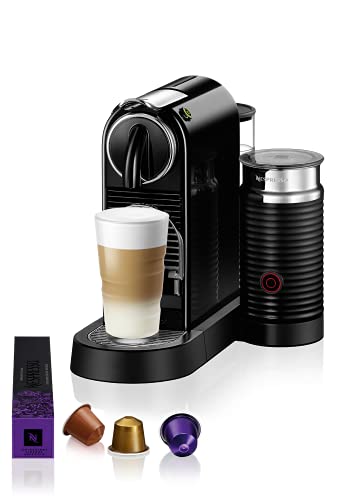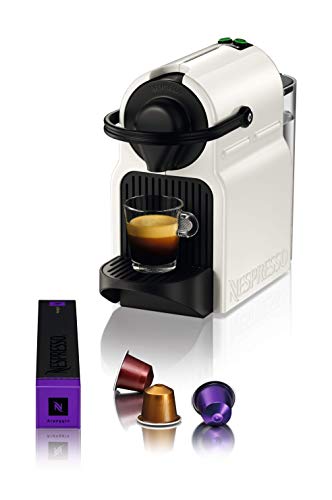The Advanced Guide To Nespresso Coffeee Machine
페이지 정보
작성자 Ila 댓글 0건 조회 4회 작성일 24-11-13 08:03본문
 Nespresso Coffee - The Essenza Mini
Nespresso Coffee - The Essenza MiniThe Essenza Mini is compact, affordable and very easy to use. It doesn't come with an adjustable drip tray or water tank to keep it small nespresso machine. But, it is a great espresso and lungo.
 It works by piercing capsules and then pumping water under pressure. This results in various sizes of espresso and coffee drinks, including 1.35-ounce espressos, 2.7-ounces double espressos, 5-ounces gran lungos or 14-ounces altos. It can be used in conjunction with an independent milk frother.
It works by piercing capsules and then pumping water under pressure. This results in various sizes of espresso and coffee drinks, including 1.35-ounce espressos, 2.7-ounces double espressos, 5-ounces gran lungos or 14-ounces altos. It can be used in conjunction with an independent milk frother.Capsules
The Nespresso system lets you create coffee at the click of the button. You can choose between one-serving cups or a larger size, and each capsule contains the right amount of beans for your desired strength. You can also add milk powder for an espresso or macchiato latte. The capsules are recyclable or disposed of with no guilt since they are made of biodegradable materials.
The pods are made from aluminium, which allows them to withstand the extreme pressure generated by the machine. The pods are sealed with a hermetically sealed seal, and the coffee grounds inside stay fresh and safe from moisture and oxygen. Nestle's environmental goals are in line with the fact that aluminum is completely recyclable.
The system has its own drawbacks. The machines are expensive both to purchase and operate. Additionally capsules are expensive to purchase and have to be replaced often. The machines are also able to only be used with capsules made by Nespresso. This has led to numerous lawsuits between Nestle and third-party firms which use the same extraction methods and ingredients as Nespresso.
Despite these disadvantages, the Nespresso system is a great option for many reasons which include premium coffee and sustainability for the environment. It's a great substitute for regular tea and coffee and it has an extraction rate that is higher than most single-serve systems. In fact, a single capsule can produce up to 14 ounces of espresso-style coffee.
The original capsule design was created in 1976 and patented in 1979. Its main features include an outer cone of aluminum foil, a flat top with a cylindrical recess into which the machine injects hot water and a small opening in the base, which is punctured from above and below. The machine then spins the capsule at 7700 rpm to infuse the coffee with water and produce an extremely thick crema.
Water
It is crucial to use high-quality water when making use of a Nespresso. This will ensure consistency in quality, and is essential for taste and texture. In general, you should choose water that is "filtered" or "spring," and avoid tap or distillation water.
In our laboratory tests, we've discovered that Nespresso machines with top-quality, softened water make more satisfying espressos and lungos than those that use hard water. This is because hard water can cause calcium deposits, as well as other issues that degrade the flavor of your coffee.
Each time you drink a cup of coffee The Nespresso machine infuses and then pumps out hot water under high pressure. This process is known as extraction. The duration, temperature and pressure of the coffee extraction process determines the flavor and intensity.
The Original machines pierce the capsule and then push it, while the Vertuo model reads the barcodes to determine the amount of water needed for each type of espresso. The Vertuo machines can brew six different sizes of drinks including espressos as well as macchiatos latte, with or without foam.
All machines that are part of the nespresso maker line can produce 19 bars. Some of the more expensive machines can also brew macchiatos latte and cappuccinos, while others offer the option to make an iced coffee.
Inissia machines and U-series machines are small making it easy to fit them in tight areas. The Nespresso Pixie is another compact option that comes with an integrated milk frother. It can also be used with the Nespresso app to access customized recipes and to reorder capsules. Nespresso is a great option for those who want to reduce their plastic footprint while also contributing to the company's sustainability program.
Temperature
While Nespresso machines are more complex than the typical coffee maker, they are also designed for speed and convenience. They are extremely fast taking only about a minute to prepare each capsule. They're also quite efficient. Unlike traditional drip coffee makers, which use more electricity per cup of coffee, Nespresso machines only use a small amount of power to brew each capsule.
Certain models of Nespresso coffee machines include a milk frother which can be used for cappuccinos and lattes. Some of these models also have a dedicated capsule container that can hold up to 12 empty capsules at a time making them easy to recycle.
The Nespresso brand is supported by several well-known kitchen equipment manufacturers, including Krups DeLonghi and Breville. However, the majority of the machines are manufactured by Eugster/Frismag the Swiss company that is among the biggest coffee machine manufacturers in the world. This has led to criticisms of the company's usage of patents and other similar strategies that printer makers to create vendor lock-in.
Pressure
In order to get the best possible espresso it is essential to keep a constant pressure throughout the extraction process. This is known as "pressure profiling." Pressure profiling entails altering the amount of pressure that is applied to the coffee grounds to achieve an optimal extraction and maximize flavor. This method can be accomplished by using various espresso machines, including Nespresso coffeemakers.
There are a variety of different ways that espresso machines can alter the pressure during the extraction process. A balanced bypass keeps the water pressure to a certain amount, typically 9 bar, regardless of the inlet. This simple and efficient method ensures that the pressure in every espresso group is the same during the extraction process.
Another option is to manually adjust the pressure with a lever or control knob. This is a more complex method, but it can provide more flexibility and control. Manual pressure regulation may result in inconsistent results. It requires a high degree of skill and attention.
Some espresso machines use a dynamic pump to adjust the pressure based on the temperature of the coffee grounds and the type being used. This is a more sophisticated system, but can produce better results than other models.
Nespresso offers a variety of machines which can be used to make espresso, lungo drinks, and some are also able to froth the milk. The Nespresso Inissia is a great machine for home baristas. It can make anywhere from 7 to 9 espressos at once and has an in-built water tank that can hold 33 ounces. The machine also has buttons for different sizes of drinks and includes a capsule tray that holds up to nine pods. The Nespresso Vertuo Next is designed to be versatile and comes with 11 milk temperatures as well as eight milk textures to choose from. It also comes with a huge, stainless steel milk frother wand as well as a container that can hold up to 18 ounces of used capsules.
Cleaning
If you use a nespresso coffee bean machine machine it leaves behind tiny limescale and mineral residues every time you make a cup. These residues can mix with your coffee, causing it to taste sour. To avoid this from happening, it is essential to regularly clean your nespresso makers machine and its components. The removable components like the drip tray capsule container, washer and drip tray should be cleaned and descalked during a deep clean. A regular rinse with clean water can aid in preventing the buildup of minerals and improve flavor.
De-scaling products can help you remove mineral deposits from your machine. These products are readily available in most outlets for coffee and appliances. You can also try vinegar. This gentle cleaner won't harm your machine, but it might take longer to dissolve the minerals than a descaling solution.
If you choose to make use of vinegar, you must first take out the coffee pods and empty the water reservoir. Then, empty the remainder of the water from the tank, as well as any water filters built-in. Pour in the vinegar and run a brew cycle without coffee pods so that it can flow through the machine. Rinse the machine with clean water, and then run several times to ensure that there aren't any vinegar traces left.
When you've got your machine clean then you can clean the exterior and its removable parts. Pay special attention to the corners and crevices, where gunk can get caught. Wash the removable parts in your dishwasher or hand wash them using mild soap and water, but be sure to rinse thoroughly. Check the seals on the capsule as well as the coffee outlet, and replace them if needed to ensure their elasticity.
댓글목록
등록된 댓글이 없습니다.



